Overview
|
A high-impact, multi-hazard storm system impacted much of the United States in the days leading up to the Christmas Holiday which resulted in extreme cold, high winds, and hazardous conditions from blowing and drifting snow. Actual temperatures fell from as high as 40 degrees Thursday night ahead of the cold front to near 0 or even sub-zero by Friday morning, resulting in any rain remaining on the ground immediately freezing (i.e. "Flash Freeze"). Wind chills across the region bottomed out as low as -30°F to -35°F on Dec 23 (Friday and Friday night) while winds gusted as high as hurricane-force (74 mph) at one point along the Lake Erie shoreline. The extreme cold continued through the Christmas weekend, with persistent sub-zero wind chills and gusty winds. Although snow amounts were nothing out of the ordinary, ranging from generally 2 to 4 inches across the area, the gusty winds and the fluffy, dry nature of the snow allowed for efficient blowing and drifting, resulting in greatly-reduced visibility at times, especially on Dec 23 (Friday morning and afternoon). The blowing snow also resulted in blizzard conditions across parts of northern Ohio and northwestern PA, including in Cleveland and Erie. This was the first Blizzard Warning the WFO CLE office has issued in nearly 10 years. |
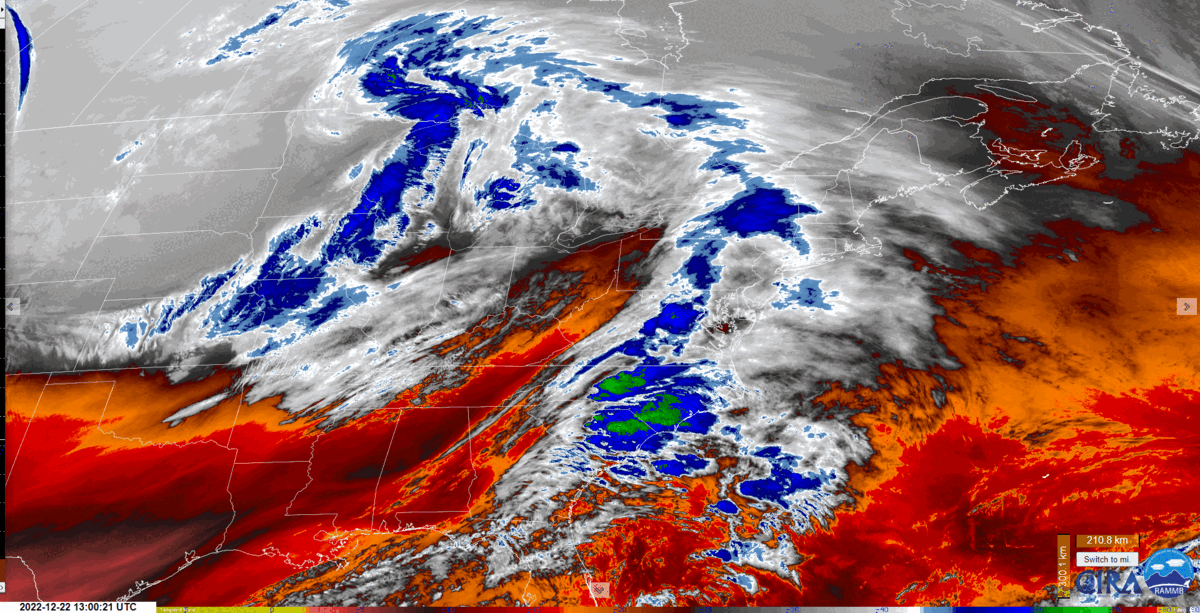 Low-level water vapor loop from Thursday, Dec 22 7 AM through Sunday, Dec 25 7 AM. |
Photos & Video
 |
 |
 |
 |
| Photo of the exposed lake floor as a result of extremely low water levels across the western basin of Lake Erie. (Barry Koehler) |
Photo of the exposed lake floor with Perry Monument in the background as a result of extremely low water levels across the western basin of Lake Erie. (Barry Koehler) |
Photo of Miller Ferries resting on the Lake floor as a result of the extremely low water levels on the western basin of Lake Erie. (Miller Ferries) |
Photo of freezing spray from Euclid Beach. (Laura Victoria) |
 |
 |
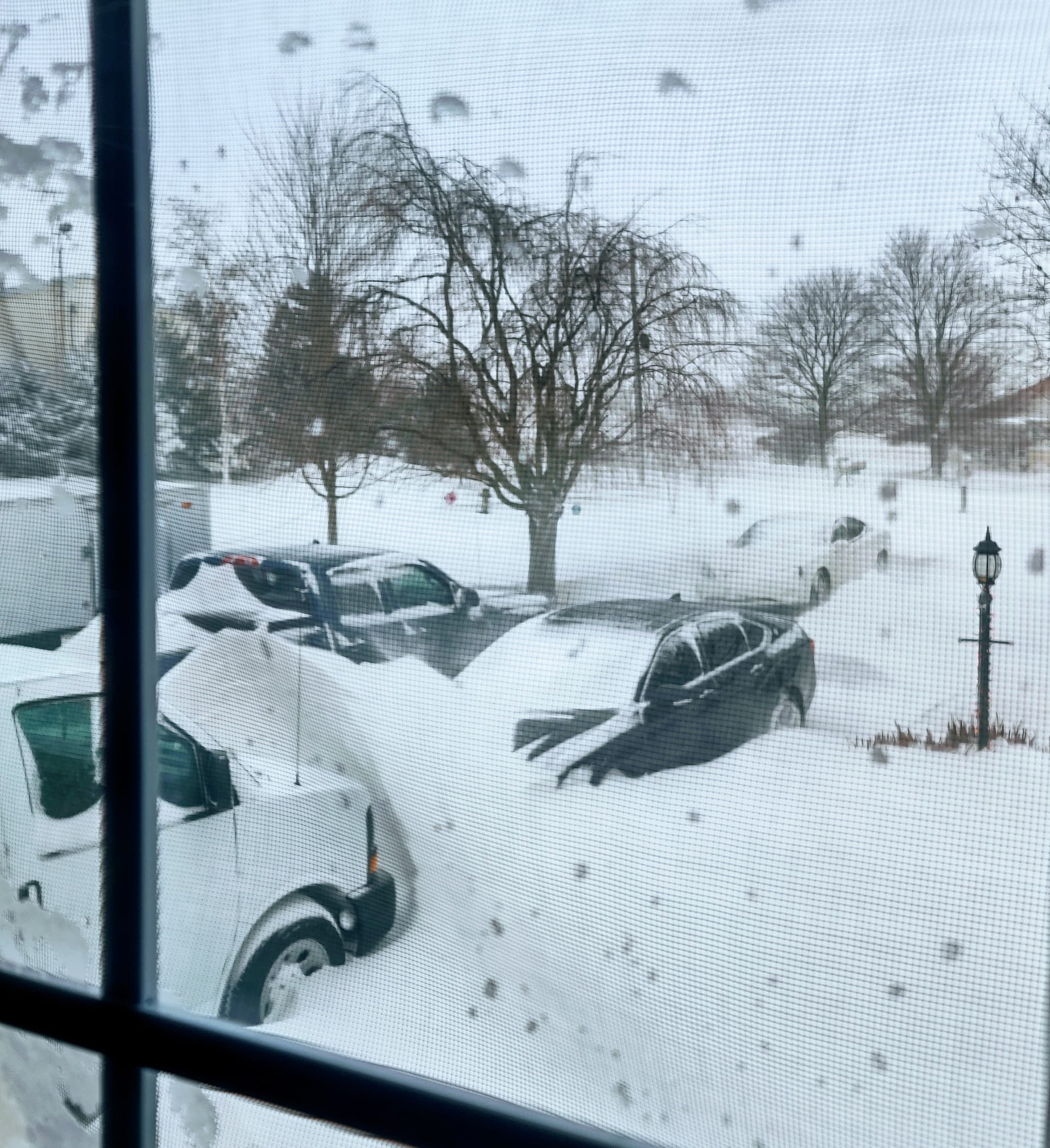 |
.jpg) |
| Whiteout conditions near New Washington, Crawford County, OH. (Anthony Haga) |
Whiteout conditions in the Cleveland area. (Kurt Voelkel) |
Photo of large snow drifts in Avery, OH. (Tony Lewis) |
Photo of plowed drifts in Shelby, OH. (Wendy Rodenbaugh) |
 |
 |
 |
 |
| Downed pine tree from strong winds in Kirtland, OH. (Chad Wacha) | Photo of ambulance on West 25th Street in Cleveland, OH. The back was covered in ice. (CARE-1975) | Photo of snow drifts in Ashtabula, OH. (Erin Buckley Arsulic) | Photo of blowing snow across the Edison Bridge in Marblehead, OH. (Denise Richmond Mcmanamon) |
 |
 |
 |
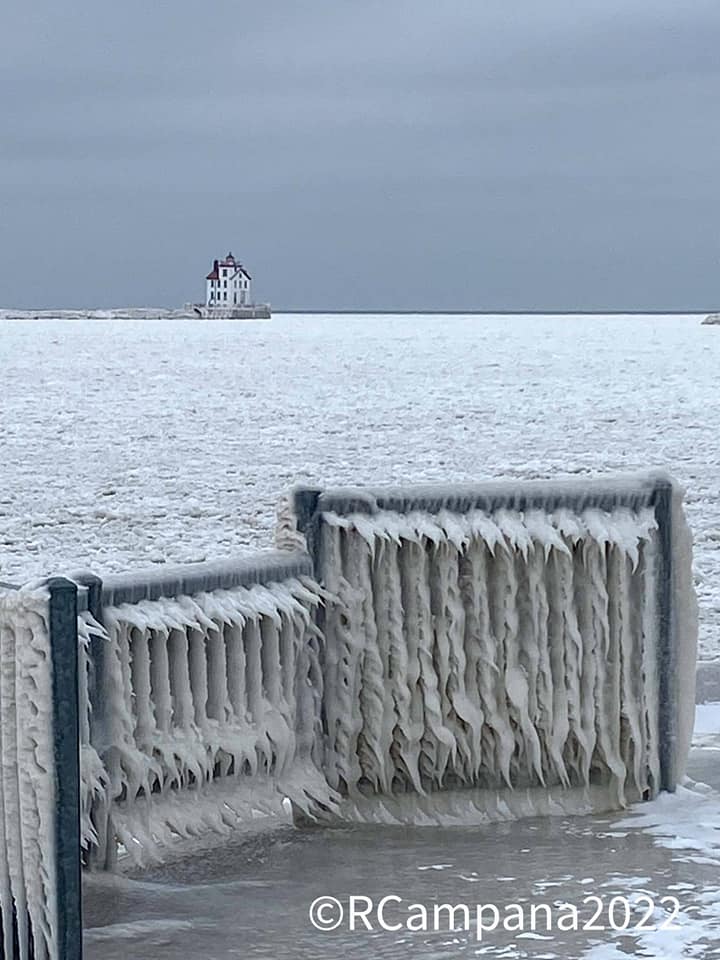 |
| Shoreline debris and high waves at Freeport Beach in North East, PA. (Kimberly Russell) | Snow drifts among 8' poly houses at Cottage Gardens in Perry, OH. (Nick Hayes) | Photo shows ice forming at Wildwood Marina in Cleveland, OH. (Laura Victoria) | Photo of Lorain Lighthouse off of Mile Long Pier in Lorain, OH and the ice accumulation on the pier. (Robert Campana) |
Radar
 |
| Radar loop from early Friday morning through Friday afternoon (Dec 23, 2022). |
Surface Observations
 |
 |
 |
 |
| Visibility and wind gust observations from Wayne County airport. Gray shading indicates periods of blizzard like conditions. | Visibility and wind gust observations from Burke Lakefront airport. Blue shading indicates 3 or more hours of blizzard conditions. | Visibility and wind gust observations from Akron Canton airport. Blue shading indicates 3 or more hours of blizzard conditions. | Visibility and wind gust observations from Cleveland Hopkins airport. Blue shading indicates 3 or more hours of blizzard conditions. |
 |
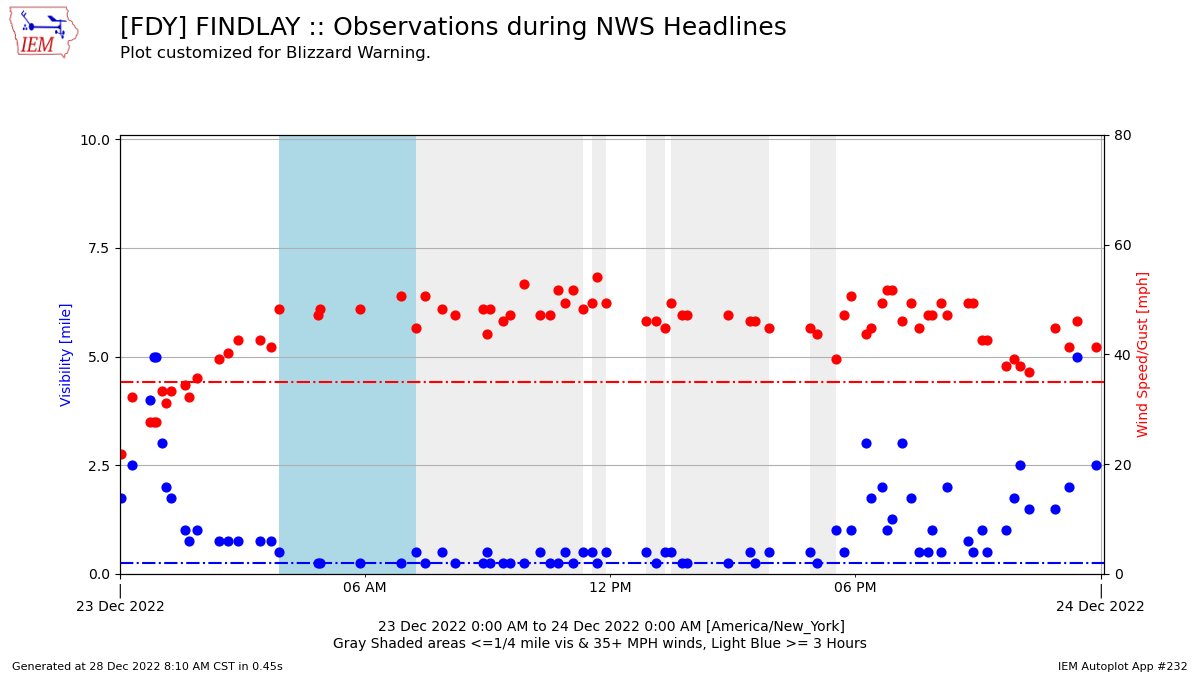 |
 |
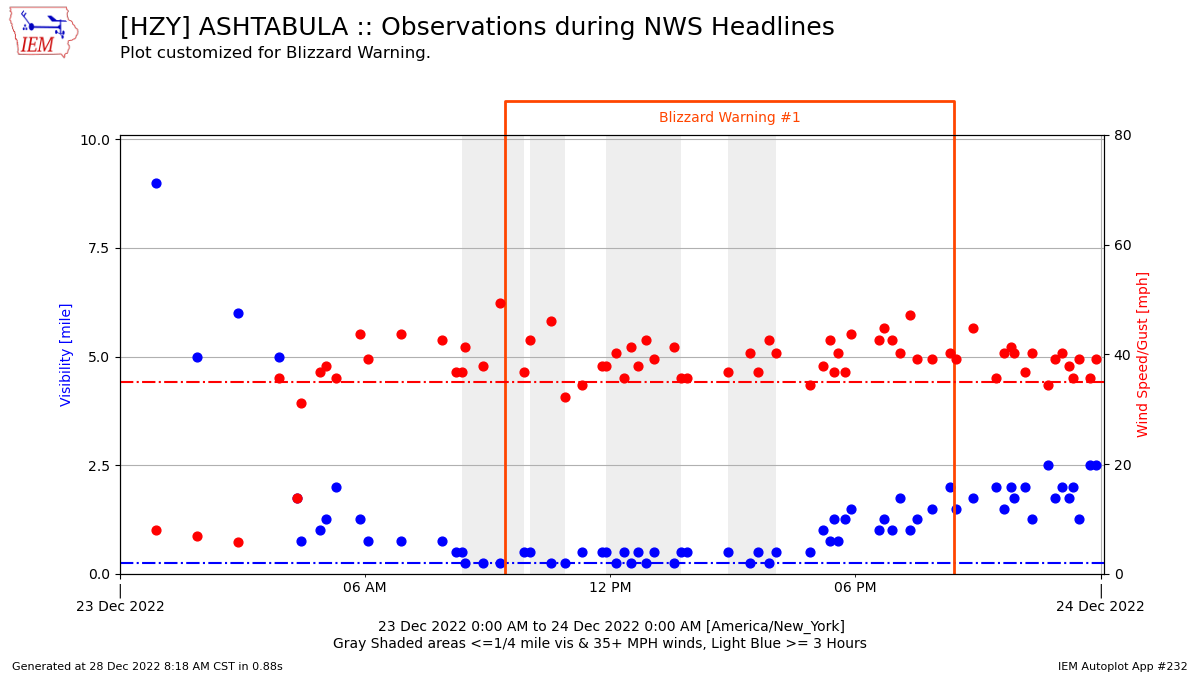 |
| Visibility and wind gust observations from Erie airport. Blue shading indicates 3 or more hours of blizzard conditions. | Visibility and wind gust observations from Findlay airport. Blue shading indicates 3 or more hours of blizzard conditions. | Visibility and wind gust observations from Meadville airport. Gray shading indicates periods of blizzard like conditions. | Visibility and wind gust observations from Ashtabula County airport. Gray shading indicates periods of blizzard like conditions. |
 |
 |
 |
 |
| Visibility and wind gust observations from Lost Nation airport in Willoughby. Blue shading indicates 3 or more hours of blizzard conditions. | Visibility and wind gust observations from Lorain County airport. Blue shading indicates 3 or more hours of blizzard conditions. | Visibility and wind gust observations from Mansfield airport. Gray shading indicates periods of blizzard like conditions. | Visibility and wind gust observations from Marion County airport. Gray shading indicates periods of blizzard like conditions. Note that observations stopped during the early morning hours of December 23rd. |
 |
 |
 |
 |
| Visibility and wind gust observations from Port Clinton airport. Blue shading indicates 3 or more hours of blizzard conditions. | Visibility and wind gust observations from Toledo Executive airport. Gray shading indicates periods of blizzard like conditions. | Visibility and wind gust observations from Toledo Express airport. Gray shading indicates periods of blizzard like conditions. | Visibility and wind gust observations from Youngstown-Warren airport. Blue shading indicates 3 or more hours of blizzard conditions. |
Storm Reports
 |
| NOHRSC 72-hour snowfall analysis from Thursday, Dec 22 7 AM through Sunday, Dec 25 7 AM. |
***These totals do not include any additional lake effect snow the
area received the night of December 24th into December 25th. ***
Public Information Statement
Spotter Reports
National Weather Service Cleveland OH
1143 AM EST Sat Dec 24 2022
The following are observations taken from the storm that has been
affecting our region since Thursday night. Appreciation is extended
to highway departments, cooperative observers, Skywarn spotters, and
media for these reports. This summary also is available on our home
page at weather.gov/cleveland
********************STORM TOTAL SNOWFALL********************
LOCATION TOTAL TIME/DATE COMMENTS
SNOWFALL MEASURED
(inches)
OHIO
...Ashland County...
3 WSW Hayesville 2.0 800 AM 12/23 Trained Spotter
4 SW Ashland 1.0 700 AM 12/23 CoCoRaHS
...Ashtabula County...
2 ESE Monroe Center 6.0 600 PM 12/23 Trained Spotter
3 E South Madison 4.3 750 PM 12/23 Trained Spotter
Edgewood 3.8 715 AM 12/24 Trained Spotter
3 W Ashtabula 3.0 700 PM 12/23 Trained Spotter
SE Ashtabula 3.0 700 AM 12/23 CoCoRaHS
2 N Cherry Valley 3.0 733 PM 12/23 Trained Spotter
2 ESE Pierpont 3.0 846 AM 12/23 Trained Spotter
3 ENE Trumbull 2.0 800 AM 12/23 Trained Spotter
2 S Harpersfield 2.0 904 AM 12/23 Trained Spotter
1 WSW Conneaut 1.5 543 PM 12/23 Trained Spotter
1 ESE Ashtabula 1.2 1020 AM 12/23 Trained Spotter
2 NNW Cherry Valley 1.0 745 AM 12/23 Trained Spotter
1 E Orwell 0.2 700 AM 12/24 Trained Spotter
...Crawford County...
3 WSW Tiro 3.0 631 PM 12/23 Trained Spotter
...Cuyahoga County...
1 W Shaker Heights 5.0 930 PM 12/23 Trained Spotter
1 ENE Lyndhurst 5.0 853 AM 12/23 Trained Spotter
1 NNE Seven Hills 5.0 800 AM 12/24 CoCoRaHS
ESE South Euclid 4.9 1030 AM 12/23 CoCoRaHS
Highland Heights 4.5 930 AM 12/23 Trained Spotter
2 NNW Parma 4.4 800 AM 12/24 CoCoRaHS
1 W Chagrin Falls 4.4 915 AM 12/23 Trained Spotter
1 NNE North Royalton 4.0 700 AM 12/23 Trained Spotter
2 SW Cleveland-Tremo 4.0 800 AM 12/23 Trained Spotter
1 SSW Westlake 3.6 800 AM 12/24 CoCoRaHS
1 SE Strongsville 3.5 800 AM 12/24 CoCoRaHS
1 SSW Lakewood 3.5 700 AM 12/23 CoCoRaHS
Westlake 3.4 800 PM 12/23 Trained Spotter
2 SSW Rocky River 3.1 800 AM 12/23 CoCoRaHS
1 ESE Broadview Heig 2.3 640 PM 12/23 Trained Spotter
2 NE Euclid 2.0 840 AM 12/23 Trained Spotter
1 WSW Cleveland Heig 1.8 700 PM 12/23 Trained Spotter
Seven Hills 0.8 700 PM 12/23 Trained Spotter
...Erie County...
Huron 3.0 630 PM 12/23 Trained Spotter
N Berlin Heights 2.5 700 AM 12/23 CoCoRaHS
6 SW Vermilion 1.5 700 AM 12/23 CoCoRaHS
ENE Milan 1.2 800 AM 12/23 CoCoRaHS
2 NNE Castalia 1.0 630 AM 12/24 CoCoRaHS
3 ESE Huron 0.7 800 AM 12/23 CoCoRaHS
...Geauga County...
2 W South Thompson 6.5 700 AM 12/24 Trained Spotter
2 W Burton 4.0 930 AM 12/24 Trained Spotter
3 SW Chardon 4.0 730 PM 12/23 Trained Spotter
3 WSW Auburn Corners 3.3 900 AM 12/24 Trained Spotter
1 S Montville 2.0 800 AM 12/23 Trained Spotter
1 SSE Montville 2.0 800 AM 12/23 CoCoRaHS
1 E Chardon 1.5 800 AM 12/23 Co-Op Observer
1 NE Middlefield 0.2 800 AM 12/23 CoCoRaHS
...Hancock County...
WSW Findlay 2.3 700 AM 12/24 CoCoRaHS
...Holmes County...
4 E Killbuck 0.3 815 AM 12/23 Trained Spotter
...Huron County...
3 NW New London 3.7 600 AM 12/24 Trained Spotter
...Knox County...
WNW Mount Vernon 2.0 800 AM 12/24 CoCoRaHS
4 NNW Fredericktown 1.2 700 AM 12/23 CoCoRaHS
2 SE Centerburg 0.4 800 AM 12/23 Co-Op Observer
...Lake County...
North Madison 5.3 727 AM 12/24 Trained Spotter
1 SSE Mentor 5.3 700 PM 12/23 Trained Spotter
3 SW Willoughby 4.8 700 AM 12/24 CoCoRaHS
1 SE Concord 4.7 726 AM 12/24 Trained Spotter
Willowick 4.0 800 AM 12/23 Trained Spotter
2 SSW Mentor-On-the- 4.0 700 PM 12/23 Trained Spotter
1 E Mentor 4.0 826 AM 12/23 Trained Spotter
1 NW Concord 4.0 900 AM 12/23 Trained Spotter
2 WNW Concord 3.5 920 PM 12/23 Trained Spotter
2 ESE Mentor 3.4 1000 AM 12/23 Trained Spotter
1 N Madison 3.0 800 PM 12/23 Trained Spotter
1 NNE Kirtland Hills 2.5 720 PM 12/23 Trained Spotter
1 WSW Madison 2.0 700 AM 12/23 Trained Spotter
1 SSE Wickliffe 2.0 745 AM 12/23 Trained Spotter
...Lorain County...
1 ENE Oberlin 3.7 740 AM 12/24 Trained Spotter
3 NE North Ridgevill 3.5 700 AM 12/24 CoCoRaHS
Elyria 3.1 430 AM 12/24 Trained Spotter
1 S Oberlin 3.0 800 AM 12/23 Co-Op Observer
6 SW Wellington 2.5 800 AM 12/23 CoCoRaHS
SE Elyria 2.3 430 AM 12/24 CoCoRaHS
2 NE North Ridgevill 2.2 1009 AM 12/23 Trained Spotter
1 NW Avon 2.0 700 AM 12/23 CoCoRaHS
...Lucas County...
7 NNE Swanton 4.5 700 AM 12/24 CoCoRaHS
2 NNE Waterville 2.5 900 AM 12/24 CoCoRaHS
3 SSW Oregon 2.0 800 AM 12/24 CoCoRaHS
3 ESE Toledo 2.0 303 AM 12/24 CoCoRaHS
3 N Holland 0.9 800 PM 12/23 Trained Spotter
...Mahoning County...
1 NW Austintown 2.6 910 AM 12/23 Trained Spotter
Canfield 2.5 900 AM 12/24 Trained Spotter
1 N Canfield 2.5 845 AM 12/24 CoCoRaHS
1 NNW Canfield 1.5 900 AM 12/23 Trained Spotter
2 NW Youngstown 0.5 1130 AM 12/23 Trained Spotter
...Marion County...
Marion 2.5 700 PM 12/23 Trained Spotter
4 SSE Marion 1.0 700 AM 12/23 CoCoRaHS
...Medina County...
1 ENE Medina 3.8 730 AM 12/24 CoCoRaHS
1 NE Brunswick 3.6 700 AM 12/23 CoCoRaHS
1 ENE Brunswick 3.6 700 PM 12/23 Trained Spotter
2 ESE Hinckley 3.0 630 PM 12/23 Trained Spotter
5 WNW Wadsworth 2.8 500 AM 12/24 CoCoRaHS
2 SSE Sharon Center 2.6 700 PM 12/23 Trained Spotter
2 E Spencer 1.9 815 AM 12/24 CoCoRaHS
2 E Homerville T 915 AM 12/24 Trained Spotter
...Morrow County...
5 ESE Mount Gilead 0.5 600 AM 12/24 CoCoRaHS
...Ottawa County...
3 N Gypsum 2.0 1000 AM 12/23 Trained Spotter
...Portage County...
Hiram 3.0 900 AM 12/24 Trained Spotter
N Hiram 3.0 700 AM 12/24 CoCoRaHS
1 NNW Mantua 3.0 800 AM 12/24 CoCoRaHS
1 W Kent 2.5 1030 AM 12/23 Trained Spotter
4 NE Kent 2.5 800 AM 12/23 CoCoRaHS
1 ENE Mogadore 2.0 656 AM 12/23 Trained Spotter
3 S Ravenna 1.5 700 AM 12/24 CoCoRaHS
2 NW Rootstown 1.0 909 AM 12/23 Trained Spotter
2 NW Streetsboro 0.8 715 AM 12/23 CoCoRaHS
1 W Craig Beach 0.7 700 AM 12/24 Co-Op Observer
2 W Kent 0.5 700 AM 12/24 CoCoRaHS
...Richland County...
1 NNE Shelby 6.0 900 AM 12/24 Trained Spotter
7 ENE Mansfield 4.0 800 AM 12/24 CoCoRaHS
1 ENE Lexington 3.5 700 AM 12/24 CoCoRaHS
1 W Mansfield 3.0 945 AM 12/24 Trained Spotter
1 NW Lexington 2.5 800 AM 12/24 CoCoRaHS
5 NW Mifflin 2.1 730 PM 12/23 Trained Spotter
5 WSW Mansfield 2.0 1100 AM 12/23 CoCoRaHS
...Seneca County...
4 S Old Fort 2.0 515 PM 12/23 Trained Spotter
2 NNW Mexico 1.0 900 AM 12/23 Trained Spotter
...Stark County...
1 NE Canton 3.0 947 AM 12/23 Trained Spotter
3 NW Waynesburg 2.9 548 PM 12/23 Trained Spotter
4 S Alliance 1.0 756 AM 12/23 Trained Spotter
4 W North Canton 1.0 800 AM 12/23 Trained Spotter
...Summit County...
1 NNE Bath 4.9 700 PM 12/23 Trained Spotter
Reminderville 4.5 1000 AM 12/24 Trained Spotter
1 N Bath 4.1 700 AM 12/24 Trained Spotter
3 SSW Barberton 4.0 800 AM 12/24 Trained Spotter
1 NW Tallmadge 3.7 800 PM 12/23 Trained Spotter
1 SE Sagamore Hills 3.3 830 AM 12/23 Trained Spotter
1 SW Munroe Falls 3.0 700 AM 12/24 Co-Op Observer
1 ESE Cuyahoga Falls 1.6 700 AM 12/23 CoCoRaHS
2 SE Cuyahoga Falls 1.5 830 AM 12/23 Trained Spotter
1 NNE Tallmadge 1.4 116 PM 12/23 CoCoRaHS
...Trumbull County...
1 N Newton Falls 4.0 700 AM 12/24 CoCoRaHS
1 WNW Newton Falls 4.0 700 AM 12/24 Trained Spotter
3 SE Gustavus 2.6 700 PM 12/23 Trained Spotter
Cortland 2.6 530 PM 12/23 Trained Spotter
Mosquito Creek Lake 0.8 700 AM 12/24 Co-Op Observer
...Wayne County...
3 ENE Doylestown 2.0 700 AM 12/23 Trained Spotter
2 SW Kidron 1.0 700 AM 12/23 Trained Spotter
...Wood County...
2 WSW Perrysburg 2.0 500 AM 12/24 CoCoRaHS
2 WSW Pemberville 2.0 530 PM 12/23 Trained Spotter
2 E Bowling Green 1.2 1200 AM 12/24 Co-Op Observer
...Wyandot County...
4 NW Harpster 2.5 800 AM 12/23 Trained Spotter
PENNSYLVANIA
...Crawford County...
6 E Atlantic 4.2 830 PM 12/23 Trained Spotter
3 WNW Springboro 4.2 700 AM 12/24 Co-Op Observer
1 NNE Meadville 3.5 420 PM 12/23 Trained Spotter
1 S Meadville 3.4 902 AM 12/23 Trained Spotter
1 WNW Conneaut Lake 2.4 700 AM 12/24 CoCoRaHS
3 SE Townville 2.1 730 PM 12/23 Trained Spotter
3 NE Cochranton 1.3 730 AM 12/24 Trained Spotter
7 NW Meadville 0.1 700 AM 12/23 CoCoRaHS
...Erie County...
2 ESE North East 8.8 700 AM 12/24 Trained Spotter
2 NW Edinboro 4.0 500 AM 12/24 Trained Spotter
2 W Avonia 3.2 720 PM 12/23 Trained Spotter
2 SSW Corry 2.0 900 AM 12/23 Trained Spotter
2 E Edinboro 1.7 800 AM 12/24 Trained Spotter
2 ESE Erie 1.0 700 AM 12/24 Trained Spotter
1 NNW Corry 0.5 730 AM 12/23 CoCoRaHS
2 WSW Erie 0.3 530 PM 12/23 Trained Spotter
1 WNW North East 0.1 800 AM 12/23 CoCoRaHS
Public Information Statement National Weather Service Cleveland OH 1215 PM EST Sat Dec 24 2022 ...MINIMUM WIND CHILL REPORTS... Location WC Temp. Time/Date Lat/Lon ...Ohio... ...Ashland County... Ashland -41 F 1135 AM 12/23 40.86N/82.32W Ashland -32 F 1129 AM 12/23 40.83N/82.38W Perrysville -30 F 1059 AM 12/23 40.65N/82.31W ...Ashtabula County... Ashtabula -29 F 0535 PM 12/23 41.78N/80.70W 1 E Geneva-on-the-Lake -22 F 0345 PM 12/23 41.86N/80.92W Ashtabula -22 F 0640 PM 12/23 41.78N/80.82W Harpersfield -21 F 0730 PM 12/23 41.73N/80.99W ...Crawford County... Crestline -23 F 0636 PM 12/23 40.79N/82.75W ...Cuyahoga County... 1 W Linndale -34 F 1115 AM 12/23 41.45N/81.79W 1 NNW Cleveland -34 F 1230 PM 12/23 41.50N/81.69W Cleveland -34 F 1151 AM 12/23 41.42N/81.85W Shaker Heights -33 F 1222 PM 12/23 41.47N/81.52W 1 SSE Rocky River -33 F 0125 PM 12/23 41.46N/81.85W Parma -32 F 0250 PM 12/23 41.37N/81.70W Clevlnd Cuyahoga -32 F 1245 PM 12/23 41.57N/81.47W Fairview High School -31 F 0600 PM 12/23 41.44N/81.86W University Heights -31 F 0235 PM 12/23 41.49N/81.53W Parma -30 F 0815 PM 12/23 41.37N/81.71W Cleveland -30 F 1153 AM 12/23 41.52N/81.68W Brook Park -29 F 1232 PM 12/23 41.39N/81.79W Solon -28 F 1011 AM 12/23 41.38N/81.47W 1 NNE Cleveland -27 F 1155 AM 12/23 41.50N/81.67W 1 ENE Westlake -24 F 1230 PM 12/23 41.46N/81.91W Shaker Heights -22 F 0109 PM 12/23 41.48N/81.52W Cleveland -22 F 0559 PM 12/23 41.44N/81.82W Olmsted Falls -22 F 1045 AM 12/23 41.36N/81.92W Middleburg Heights -22 F 0245 PM 12/23 41.35N/81.80W Lakewood -21 F 1145 AM 12/23 41.48N/81.80W Cleveland -21 F 0635 PM 12/23 41.44N/81.73W Stongsville -20 F 1146 AM 12/23 41.33N/81.81W ...Erie County... Sandusky -31 F 1200 PM 12/23 41.38N/82.64W Sandusky -30 F 1148 AM 12/23 41.44N/82.64W Vermilion -25 F 0105 PM 12/23 41.42N/82.37W Huron -23 F 0745 PM 12/23 41.38N/82.46W ...Geauga County... Munson Twp -33 F 0145 PM 12/23 41.51N/81.18W Bainbridge -30 F 1215 PM 12/23 41.39N/81.39W Chardon -29 F 0148 PM 12/23 41.50N/81.24W NOVELTY -28 F 0317 PM 12/23 41.50N/81.34W Auburn -27 F 1230 PM 12/23 41.36N/81.27W Auburn Township -26 F 0805 PM 12/23 41.39N/81.24W Thompson Twp -22 F 0905 PM 12/23 41.69N/81.09W ...Hancock County... Arcadia -42 F 1015 AM 12/23 41.12N/83.52W Findlay -38 F 1045 AM 12/23 41.04N/83.55W Jenera -36 F 0915 AM 12/23 40.94N/83.75W Findlay -36 F 0953 AM 12/23 41.02N/83.67W Van Buren -34 F 1005 AM 12/23 41.14N/83.65W ...Holmes County... Holmes County Airport -34 F 1155 AM 12/23 40.54N/81.96W ...Huron County... Bellevue -36 F 0305 PM 12/23 41.24N/82.77W New London -29 F 1101 AM 12/23 41.09N/82.44W North Fairfield -28 F 0340 PM 12/23 41.12N/82.62W ...Knox County... Mt Vernon Knox -35 F 0955 AM 12/23 40.33N/82.53W Centerburg -33 F 0932 AM 12/23 40.30N/82.64W ...Lake County... Wickliffe -33 F 1209 PM 12/23 41.60N/81.48W Mentor -33 F 1240 PM 12/23 41.70N/81.34W Fairport, OH -33 F 0230 PM 12/23 41.76N/81.28W Willoughby -31 F 0155 PM 12/23 41.67N/81.37W Mentor -29 F 0225 PM 12/23 41.67N/81.33W Mentor -25 F 0240 PM 12/23 41.73N/81.31W Mentor -25 F 0835 PM 12/23 41.64N/81.31W Kirtland -22 F 0347 PM 12/23 41.61N/81.33W Mentor -21 F 0800 PM 12/23 41.72N/81.35W WICKLIFFE -20 F 0239 PM 12/23 41.60N/81.47W ...Lorain County... Kipton -34 F 1020 AM 12/23 41.24N/82.29W Lorain -34 F 1115 AM 12/23 41.49N/82.12W Avon -32 F 1056 AM 12/23 41.44N/82.05W Lorain Elyria -32 F 1253 PM 12/23 41.35N/82.18W Wellington -29 F 0115 PM 12/23 41.16N/82.19W Elyria -26 F 0317 PM 12/23 41.38N/82.10W Avon Lake -24 F 0139 PM 12/23 41.50N/82.05W Avon -23 F 1100 AM 12/23 41.45N/82.03W Lorain -23 F 1059 AM 12/23 41.47N/82.19W AVON LAKE -23 F 0220 PM 12/23 41.49N/81.99W Amherst -22 F 1045 AM 12/23 41.39N/82.28W ...Lucas County... 2 SSE Ottawa Hills -36 F 1055 AM 12/23 41.63N/83.63W 1 NNE Ottawa Hills -31 F 0945 AM 12/23 41.69N/83.63W 2 E Toledo -31 F 1100 AM 12/23 41.65N/83.53W Toledo -29 F 1032 AM 12/23 41.58N/83.80W Toledo, OH -29 F 1112 AM 12/23 41.69N/83.47W 2 NNE Toledo -28 F 1250 PM 12/23 41.70N/83.56W 1.5 W Ottawa Hills (WEATHERS -24 F 1200 PM 12/23 41.67N/83.67W Maumee -24 F 1149 AM 12/23 41.60N/83.71W Curtice -23 F 1110 PM 12/23 41.66N/83.25W Waterville -21 F 0120 PM 12/23 41.46N/83.82W ...Mahoning County... Youngstown -25 F 0550 PM 12/23 41.10N/80.65W New Middletown -24 F 0257 PM 12/23 40.97N/80.55W Youngstown -20 F 0228 PM 12/23 41.05N/80.69W ...Marion County... Marion -36 F 0900 AM 12/23 40.58N/83.07W Marion -26 F 1145 AM 12/23 40.57N/83.11W ...Medina County... 1 W Brunswick -38 F 1200 PM 12/23 41.25N/81.84W Brunswick -36 F 0136 PM 12/23 41.23N/81.82W Homerville -33 F 1135 AM 12/23 41.02N/82.10W Valley City -31 F 1235 PM 12/23 41.21N/81.89W Seville -27 F 1245 PM 12/23 41.03N/81.83W 3 N Rittman -26 F 1205 PM 12/23 41.02N/81.79W Hinckley -25 F 0130 PM 12/23 41.23N/81.77W Medina -25 F 1045 AM 12/23 41.14N/81.85W Seville -22 F 1110 AM 12/23 41.00N/81.82W Brunswick -22 F 1046 AM 12/23 41.25N/81.81W Sharon Township -22 F 1045 AM 12/23 41.08N/81.75W Medina -20 F 0528 PM 12/23 41.17N/81.84W ...Morrow County... 6 SSE Galion -37 F 0940 AM 12/23 40.64N/82.76W Marengo -28 F 1033 AM 12/23 40.39N/82.84W ...Ottawa County... MARTIN -37 F 1139 AM 12/23 41.57N/83.33W Port Clinton -36 F 1215 PM 12/23 41.52N/82.87W Port Clinton -28 F 1030 AM 12/23 41.52N/82.99W Port Clinton -28 F 1003 AM 12/23 41.51N/82.92W Danbury Twp -26 F 1130 AM 12/23 41.53N/82.78W ...Portage County... 4 N Ravenna -30 F 0535 PM 12/23 41.22N/81.25W Rootstown -29 F 0639 PM 12/23 41.10N/81.27W 3 SE Brimfield -24 F 0510 PM 12/23 41.06N/81.31W Ravenna -24 F 0125 PM 12/23 41.16N/81.28W ...Richland County... Mansfield -36 F 1252 PM 12/23 40.82N/82.52W Shelby -32 F 0126 PM 12/23 40.89N/82.66W Shiloh -32 F 1128 AM 12/23 40.89N/82.46W Mansfield -31 F 1106 AM 12/23 40.77N/82.52W ...Sandusky County... Sandusky County Regional Air -37 F 0955 AM 12/23 41.30N/83.04W Fremont -33 F 1100 AM 12/23 41.36N/83.12W Fremont -32 F 1100 AM 12/23 41.40N/83.22W ...Seneca County... 1.9 W Tiffin (WEATHERSTEM) -27 F 0700 AM 12/23 41.11N/83.21W Tiffin -20 F 1015 AM 12/23 41.12N/83.17W ...Stark County... Louisville -35 F 0245 PM 12/23 40.83N/81.24W Canal Fulton -32 F 0115 PM 12/23 40.88N/81.53W Hartville -29 F 0425 PM 12/23 40.98N/81.36W Massillon -27 F 1000 PM 12/23 40.85N/81.51W Canton -22 F 0325 PM 12/23 40.84N/81.45W ...Summit County... Copley -31 F 0305 PM 12/23 41.07N/81.66W Akron-Canton Regional Arpt -31 F 0151 PM 12/23 40.92N/81.45W Akron -30 F 0204 PM 12/23 41.08N/81.52W Akron Fulton International A -30 F 0154 PM 12/23 41.03N/81.47W Lakemore -30 F 0100 PM 12/23 41.02N/81.43W Reminderville -29 F 0247 PM 12/23 41.35N/81.39W 2 SSW Northfield -28 F 1200 PM 12/23 41.31N/81.54W Fairlawn -28 F 1220 PM 12/23 41.12N/81.60W Cuyahoga Falls -28 F 0430 PM 12/23 41.14N/81.52W 2 N Montrose-Ghent -27 F 0200 PM 12/23 41.19N/81.64W Twinsburg -27 F 0230 PM 12/23 41.30N/81.46W Tallmadge -27 F 0240 PM 12/23 41.11N/81.41W Tallmadge -26 F 0115 PM 12/23 41.12N/81.44W Barberton -23 F 1235 PM 12/23 40.99N/81.58W Fairlawn -22 F 0250 PM 12/23 41.13N/81.60W ...Trumbull County... Youngstown -31 F 0551 PM 12/23 41.25N/80.67W Newton Falls -30 F 0209 PM 12/23 41.20N/80.97W Cortland -30 F 0159 PM 12/23 41.31N/80.74W ...Wayne County... Dalton -37 F 1100 AM 12/23 40.80N/81.67W Wooster -36 F 1219 PM 12/23 40.87N/81.88W 1 SSW Wooster -33 F 1225 PM 12/23 40.80N/81.94W ...Wood County... Lemoyne -36 F 1046 AM 12/23 41.49N/83.47W 1 WNW Tontogany -32 F 1110 AM 12/23 41.43N/83.78W Toledo -32 F 1053 AM 12/23 41.57N/83.48W Perrysburg -29 F 1018 AM 12/23 41.55N/83.64W Bowling Green -29 F 1100 AM 12/23 41.37N/83.65W Perrysburg -21 F 0435 PM 12/23 41.52N/83.64W ...Wyandot County... 3 NW Upper Sandusky -34 F 1004 AM 12/23 40.88N/83.32W ...Pennsylvania... ...Crawford County... SR-77 @ Green Hill -32 F 0510 PM 12/23 41.71N/79.98W Meadville -32 F 0501 PM 12/23 41.63N/80.22W Sr-77 @ Green Hill -32 F 0510 PM 12/23 41.71N/79.98W Geneseo -31 F 0759 AM 12/23 41.73N/80.13W Saegertown -28 F 0645 PM 12/23 41.70N/80.20W 2.9 SW Linesville (WEATHERST -23 F 0640 PM 12/23 41.62N/80.45W Cochranton -22 F 1026 PM 12/23 41.52N/80.05W ...Erie County... Edinboro -33 F 0700 PM 12/23 41.93N/80.13W Erie -29 F 0251 PM 12/23 42.08N/80.18W I-90 near Clark Rd Overpass -26 F 0535 PM 12/23 42.13N/79.94W Erie -26 F 0135 PM 12/23 41.88N/80.08W I-90 Near Clark Rd Overpass -26 F 0535 PM 12/23 42.13N/79.94W Erie -26 F 0200 AM 12/24 42.23N/79.86W I-90 E/B @ MM 1 / Exit 3 Wel -22 F 0505 PM 12/23 41.94N/80.50W East Springfield -22 F 0745 PM 12/23 41.96N/80.40W I-90 E B @ Mm 1 Exit 3 Welc -22 F 0505 PM 12/23 41.94N/80.50W ...Ohio... ...Maritime Stations... Cleveland, OH -28 F 0936 AM 12/23 41.54N/81.64W Conneaut Light -25 F 0634 PM 12/23 41.98N/80.56W && Observations are collected from a variety of sources with varying equipment and exposures. We thank all volunteer weather observers for their dedication. Not all data listed are considered official.
Public Information Statement National Weather Service Cleveland OH 1210 PM EST Sat Dec 24 2022 ...HIGHEST WIND REPORTS... Location Speed Time/Date Lat/Lon ...Ohio... ...Ashland County... Ashland 40 MPH 0149 PM 12/23 40.83N/82.38W Ashland 35 MPH 0135 PM 12/23 40.86N/82.32W ...Ashtabula County... Ashtabula 51 MPH 0641 AM 12/23 41.78N/80.70W Harpersfield 40 MPH 0816 AM 12/23 41.73N/80.99W ...Cuyahoga County... Parma 65 MPH 0220 PM 12/23 41.37N/81.70W Cleveland 55 MPH 0836 AM 12/23 41.52N/81.68W Shaker Heights 54 MPH 0224 PM 12/23 41.47N/81.52W Cleveland 52 MPH 1104 AM 12/23 41.42N/81.85W Clevlnd Cuyahoga 49 MPH 0645 PM 12/23 41.57N/81.47W Fairview High School 47 MPH 1000 AM 12/23 41.44N/81.86W Brook Park 45 MPH 0157 PM 12/23 41.39N/81.79W Solon 36 MPH 0541 AM 12/23 41.38N/81.47W Stongsville 36 MPH 0916 AM 12/24 41.33N/81.81W Middleburg Heights 35 MPH 0345 PM 12/23 41.35N/81.80W ...Erie County... Sandusky 51 MPH 1128 AM 12/24 41.44N/82.64W Sandusky 37 MPH 0940 AM 12/24 41.38N/82.64W ...Geauga County... Auburn 42 MPH 1220 AM 12/24 41.36N/81.27W Chardon 39 MPH 0258 PM 12/23 41.50N/81.24W ...Hancock County... Arcadia 68 MPH 0905 AM 12/23 41.12N/83.52W Findlay 55 MPH 0433 PM 12/23 41.02N/83.67W Jenera 49 MPH 0435 AM 12/23 40.94N/83.75W Findlay 42 MPH 1045 AM 12/23 41.04N/83.55W ...Holmes County... Holmes County Airport 48 MPH 0555 AM 12/23 40.54N/81.96W ...Huron County... Bellevue 48 MPH 0300 PM 12/23 41.24N/82.77W New London 35 MPH 0245 PM 12/23 41.09N/82.44W ...Knox County... Mt Vernon Knox 43 MPH 0455 AM 12/23 40.33N/82.53W Centerburg 39 MPH 0942 AM 12/23 40.30N/82.64W ...Lake County... Fairport, OH 74 MPH 0548 PM 12/23 41.76N/81.28W Wickliffe 57 MPH 0159 PM 12/23 41.60N/81.48W Willoughby 51 MPH 0915 AM 12/23 41.67N/81.37W Eastlake 42 MPH 0615 AM 12/23 41.68N/81.42W Mentor 39 MPH 0415 PM 12/23 41.70N/81.34W Mentor 38 MPH 0925 AM 12/23 41.69N/81.37W WICKLIFFE 38 MPH 0610 PM 12/23 41.60N/81.47W Mentor 36 MPH 0555 AM 12/23 41.72N/81.35W Mentor 35 MPH 0540 AM 12/23 41.67N/81.33W ...Lorain County... Lorain Elyria 54 MPH 0226 PM 12/23 41.35N/82.18W AVON LAKE 50 MPH 0910 PM 12/23 41.49N/81.99W Lorain 49 MPH 0514 AM 12/23 41.47N/82.19W Kipton 45 MPH 1220 PM 12/23 41.24N/82.29W Elyria 44 MPH 0852 AM 12/24 41.38N/82.10W Wellington 43 MPH 0845 AM 12/23 41.16N/82.19W Avon Lake 40 MPH 1129 AM 12/24 41.50N/82.05W Avon 40 MPH 1056 AM 12/23 41.44N/82.05W Lorain 36 MPH 0600 AM 12/23 41.49N/82.12W ...Lucas County... Toledo 52 MPH 0944 AM 12/23 41.58N/83.80W Toledo, OH 47 MPH 0748 PM 12/23 41.69N/83.47W Maumee 38 MPH 1036 AM 12/23 41.60N/83.71W ...Mahoning County... Youngstown 37 MPH 1030 AM 12/23 41.10N/80.65W ...Marion County... Marion 35 MPH 0905 AM 12/23 40.58N/83.07W ...Medina County... Homerville 50 MPH 0135 PM 12/23 41.02N/82.10W Brunswick 49 MPH 0136 PM 12/23 41.23N/81.82W Seville 38 MPH 0535 AM 12/23 41.03N/81.83W Medina 38 MPH 1045 AM 12/23 41.14N/81.85W Hinckley 35 MPH 0115 AM 12/24 41.23N/81.77W ...Ottawa County... 9 NE Port Clinton 66 MPH 0400 PM 12/23 41.63N/82.84W Port Clinton 62 MPH 1035 AM 12/23 41.52N/82.87W MARTIN 57 MPH 0250 PM 12/23 41.57N/83.33W 4 WNW Port Clinton 57 MPH 0730 PM 12/23 41.55N/83.02W Port Clinton 48 MPH 1000 AM 12/23 41.52N/82.99W Port Clinton 45 MPH 0917 PM 12/23 41.51N/82.92W Danbury Twp 40 MPH 0200 PM 12/23 41.53N/82.78W ...Portage County... Rootstown 43 MPH 1037 AM 12/24 41.10N/81.27W 4 N Ravenna 43 MPH 1015 PM 12/23 41.22N/81.25W ...Richland County... Mansfield 47 MPH 1034 AM 12/23 40.82N/82.52W Shelby 40 MPH 0406 PM 12/23 40.89N/82.66W ...Sandusky County... Sandusky County Regional Air 58 MPH 0155 PM 12/23 41.30N/83.04W Fremont 48 MPH 1130 AM 12/23 41.36N/83.12W Fremont 45 MPH 0100 PM 12/23 41.40N/83.22W ...Seneca County... 1.9 W Tiffin (WEATHERSTEM) 43 MPH 0700 AM 12/23 41.11N/83.21W ...Stark County... Canal Fulton 44 MPH 0555 PM 12/23 40.88N/81.53W Massillon 35 MPH 0341 PM 12/23 40.85N/81.51W ...Summit County... Akron Fulton International A 51 MPH 0527 AM 12/23 41.03N/81.47W Akron-Canton Regional Arpt 49 MPH 0628 AM 12/23 40.92N/81.45W Barberton 42 MPH 1217 PM 12/23 40.99N/81.58W Hudson 41 MPH 0230 PM 12/23 41.26N/81.42W Tallmadge 39 MPH 0825 PM 12/23 41.12N/81.44W Fairlawn 35 MPH 0500 PM 12/23 41.13N/81.60W ...Trumbull County... Cortland 55 MPH 0109 PM 12/23 41.31N/80.74W Youngstown 51 MPH 0232 PM 12/23 41.25N/80.67W Newton Falls 45 MPH 0614 PM 12/23 41.20N/80.97W ...Wayne County... Wooster 51 MPH 1050 AM 12/23 40.87N/81.88W Dalton 39 MPH 1100 AM 12/23 40.80N/81.67W ...Wood County... Toledo 56 MPH 0717 AM 12/23 41.57N/83.48W Lemoyne 52 MPH 0156 PM 12/23 41.49N/83.47W Perrysburg 45 MPH 0428 PM 12/23 41.55N/83.64W 1 WNW Tontogany 45 MPH 0830 PM 12/23 41.43N/83.78W ...Pennsylvania... ...Crawford County... SR-77 @ Green Hill 46 MPH 0150 PM 12/23 41.71N/79.98W Sr-77 @ Green Hill 46 MPH 0150 PM 12/23 41.71N/79.98W Saegertown 44 MPH 0115 PM 12/23 41.70N/80.20W Meadville 44 MPH 0712 AM 12/23 41.63N/80.22W Springboro 3 WNW 40 MPH 0700 AM 12/23 41.82N/80.43W ...Erie County... Erie 55 MPH 0131 PM 12/23 42.08N/80.18W 3 NE North East 48 MPH 0430 PM 12/23 42.26N/79.79W I-90 near Clark Rd Overpass 46 MPH 0450 PM 12/23 42.13N/79.94W I-90 Near Clark Rd Overpass 46 MPH 0450 PM 12/23 42.13N/79.94W I-90 E/B @ MM 1 / Exit 3 Wel 40 MPH 0720 AM 12/23 41.94N/80.50W I-90 E B @ Mm 1 Exit 3 Welc 40 MPH 0720 AM 12/23 41.94N/80.50W Erie 37 MPH 0415 PM 12/23 42.08N/80.14W Erie 36 MPH 0738 AM 12/23 42.07N/80.16W Erie 36 MPH 0200 AM 12/24 42.23N/79.86W East Springfield 35 MPH 0745 PM 12/23 41.96N/80.40W ...Ohio... ...Maritime Stations... 2 NNE Sandusky 72 MPH 0454 PM 12/23 41.49N/82.70W Conneaut Light 71 MPH 0729 AM 12/23 41.98N/80.56W 8 ENE Oregon 68 MPH 0110 PM 12/23 41.70N/83.26W Vermilion 62 MPH 0818 AM 12/23 41.43N/82.36W 1 W Geneva-on-the-Lake 60 MPH 0630 AM 12/23 41.86N/80.97W Huron 53 MPH 0800 PM 12/23 41.40N/82.55W Cleveland - Edgewater 52 MPH 0914 AM 12/23 41.50N/81.73W Cleveland, OH 51 MPH 0936 AM 12/23 41.54N/81.64W 2 N Ashtabula 43 MPH 0700 AM 12/23 41.92N/80.80W ...Pennsylvania... 3 NNW Erie 51 MPH 0754 AM 12/23 42.17N/80.10W 2 NE Avonia 46 MPH 0700 AM 12/23 42.08N/80.24W
Additional...
PNS of 4-day storm total from the NWS BUF office
Environment
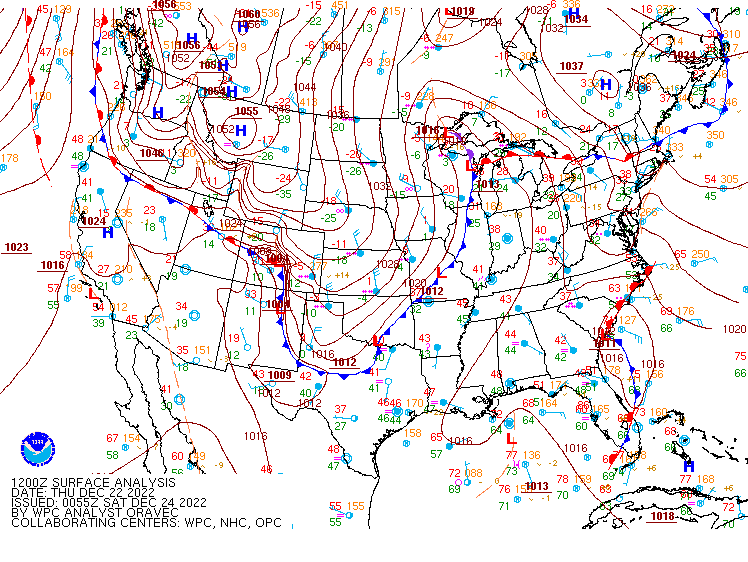 |
 |
 |
 |
| Figure 1: WPC surface analysis from Dec 22, 2022 7 AM through Dec 25, 2022 7 AM. | Figure 2: 300 mb analysis from Dec 22, 2022 7 AM through Dec 25, 2022 7 AM. | Figure 3: 500 mb analysis from Dec 22, 2022 7 AM through Dec 25, 2022 7 AM. | Figure 4: 850 mb analysis from Dec 22, 2022 7 AM through Dec 25, 2022 7 AM. |
 |
 |
.png) |
| Figure 5: 2-hour pressure change analysis (rises & falls) from Dec 22, 2022 7 PM through Dec 23, 2022 7 AM. | Figure 6: 3-hour temperature change analysis (increases in red, decreases in red) from Dec 22, 2022 7 PM through Dec 23, 2022 7 AM. | Temperature time series for KCLE, showing the dramatic drop in ambient temperatures Thursday night into Friday morning behind a strong cold front. Temperatures fell from as high as 43F around 1 AM to as low as -4F at noon. |
Water Levels
 |
 |
 |
| Toledo water level graph during the course of the event. Note that the observed water levels dropped as low as 7 to 8 feet below the low water datum. This broke the record for the lowest water measured at this site by 1.35 feet. The previously record was set on 30 January 2008. | Marblehead water level graph during the course of the event. Note that the observed water levels dropped as low as 3 to 4 feet below low water datum. | Buffalo water level graph during the course of the event. Note that the observed water levels rose to as high as 10 to 11 feet above low water datum, resulting in extensive coastal flooding along the shoreline of Lake Erie. |
 |
Media use of NWS Web News Stories is encouraged! Please acknowledge the NWS as the source of any news information accessed from this site. |
 |